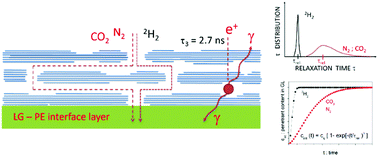Anomalous molecular infiltration in graphene laminates†
Abstract
Graphene laminated (GL) coatings formed by stacked few layer graphene (FLG) nanocrystals were deposited on low-density polyethylene (PE) films by the mechanical rubbing technique. Molecular transport through the bilayer membrane was studied by the gas phase permeation technique by monitoring the CO2, N2 and 2H2 transport fluxes in transient conditions. The results evidenced that the transport exhibited anomalous character. The experimental data could be reproduced assuming that the penetrant concentration in the GL coating, cint(t), reached a saturation value cs following compressed exponential kinetics cint(t) = cs[1 − e−(λrelt)β]. The relaxation time τrel = 1/λrel showed thermally activated behavior, and its value increased with the kinetic diameter of the penetrant molecules. The critical exponent β = 1.5 ± 0.1 for CO2 and N2 and β = 2.0 ± 0.1 for 2H2 did not change with temperature. Positron annihilation lifetime spectroscopy (PALS) analysis indicated that the average cross-section (hg) of the cavities in the GL coating exhibited comparable size to the kinetic diameter (σk) of the penetrant molecules. The results could be explained by assuming that the molecular infiltration in the GL structure occurred in nano-channels having distributed path lengths where the penetrant transport obeyed a configurational diffusion mechanism.

- This article is part of the themed collection: 2018 PCCP HOT Articles


 Please wait while we load your content...
Please wait while we load your content...